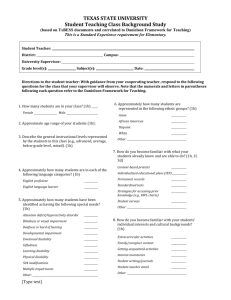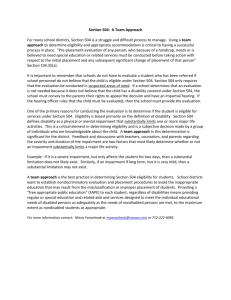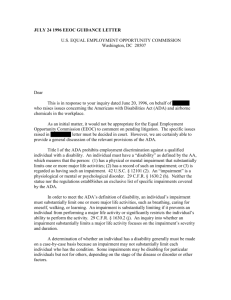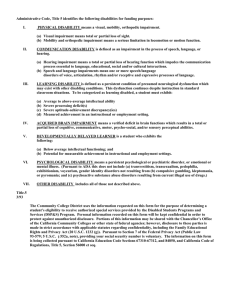Employment Law – New Sources of Liability
advertisement
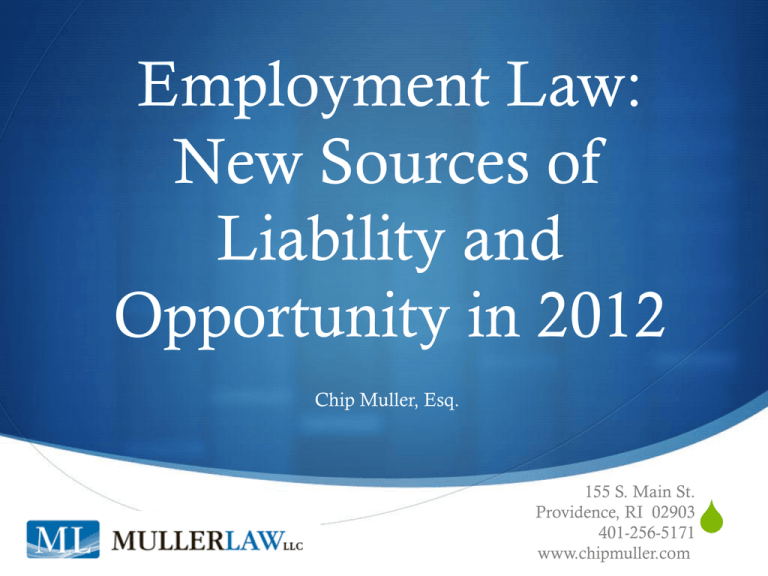
Employment Law: New Sources of Liability and Opportunity in 2012 Chip Muller, Esq. 155 S. Main St. Providence, RI 02903 401-256-5171 www.chipmuller.com S General Trends S Employee protections broadening S EEOC charges are up S Risks to companies increasing S Disability regulations broadened S HR & outside counsel roles more demanding “Associational Retaliation” Thompson v. North American Stainless S Title VII Retaliation Protection S Illegal to take action against anyone who: S Opposes an act illegal under Title VII, etc., or S Participates in a discrimination/harassment reporting/investigation procedure. S Less damaging action against employee suffices: S “materially adverse” to a reasonable employee / applicant. S Materially adverse action “well might have ‘dissuaded a reasonable worker from making or supporting a charge of discrimination.’” The Thompsons-to-Be Eric U.S. Supreme Court S Can Eric sue? S Slippery slope S Yes: “Zone of Interests” to be protected by Title VII S Hurting Eric was employers way of hurting Miriam S Might well have dissuaded Miriam from making complaint. Big Question How broad is “zone of interest”? S Firing a close family member will almost always qualify… S Inflicting a milder reprisal on a mere acquaintance will almost never do so… S “beyond that we are reluctant to generalize.” More Retaliation Claims S 36,258 retaliation complaints filed during 2010 S 8% increase from 2008 S 61% increase from 2006 Action Items (#1) S When signing off on actions which affect employee, S Strong investigations S Increase your breadth of perspective S Note family relationship? S Document non-discriminatory reasons for termination S Supervisor training Cat’s Paw Grows Staub v. Proctor Hospital S “Cat’s Paw” USERRA S Adverse employment action illegal if employee’s S Membership in a uniformed service or S Obligations to a uniformed service is a S Motivating Factor in the employment decision. 38 U.S.C. sec. 4311 S Like Title VII Private Staub Pounce Under Cover of Darkness S Written warning. S Required Staub to report to supervisors when not working S Eight months later: supervisor reports to VP of HR: Staub violated terms of warning S VP of HR reviews file S VP of HR fires Staub for ignoring warning S Staub says direct supervisors’ write-ups all lies Monkey Takes Off Cat’s Paw: Players Cat’s Paw: Old Theory S HR’s independent decision to take adverse action breaks causal connection between supervisor’s bigotry and adverse action S when assessing independence of HR, courts look for S Employee’s opportunity to address allegations in question S HR’s awareness employee thinks underlying recommendation is motivated by bias or retaliation. Thompson v. Coca-Cola Co., 522 F.3d 168, 178 (1st Cir. 2008). Cat’s Paw: Old View HR Investigation Can More Easily Break Causal Connection Cat’s Paw: New Law S Supervisor’s biased report may remain a causal link if: S HR investigation takes biased report into account without determining that the adverse action was entirely justified aside from the supervisor's recommendation. S If HR investigation relies on facts provided by biased supervisor, the employer will have effectively delegated the factfinding portion of the investigation to the biased supervisor. Staub Wins S Supervisors biased S Acted as agent of employer S HR VP based decision to terminate in part on: S Staub’s failure to follow corrective action S Supervisor was source of data that Staub did not follow corrective action Action Items (#2) S Thorough investigation based on best practices S Seek raw data; ask for examples S Account for bias S Retrain decisionmakers S Consider more independent investigators S Document investigation and legitimate reasons for adverse employment action ADAAA New EEOC Regulations S OLD PARADIGM S Substantially Limits = “Severely restricts” S Disabilities Which Used to Fall Short S Diabetes S MS S Cerebral Palsy S Asperger’s Syndrome S See, e.g., Ziehm v. RadioShack Corp., 2010 U.S. Dist. LEXIS 136782 (D. Me. May 22, 2010). S Catch-22 Mandate to EEOC S Refine regulations S Make it easier for individuals with impairments to show that they are S substantially limited S in one or more major life activities ADA Regs: Why Important S Power of statute S Enforcement of ADA Priority for EEOC in 2011 S More Charges-- 25,000 in 2010 (up 30%) New Paradigm S “The primary object of attention in cases …should be whether covered entities have: S complied with obligations and S whether discrimination has occurred, S not whether the individual meets the definition of disability. 29 C.F.R. §1630.1(c)(4). ADA Basics: “Disability” S Physical or mental impairment that S substantially limits S one or more of the major life activities; S A record of such an impairment; S substantially limits S one or more of the major life activities; or S Being regarded as having . . . an impairment. 29 CFR 1630.2 ADA Basics: Liability S Illegal to discriminate against individual S Must make reasonable accommodation for qualified employee (1) “Impairment” S Physical or mental impairment that S substantially limits S one or more of the major life activities; S A record of such an impairment; S substantially limits S one or more of the major life activities; or S Being regarded as having an impairment. 29 CFR 1630.2 “Impairment” Physical S Any physiological disorder or condition, S cosmetic disfigurement, or anatomical loss S affecting one or more body systems, S neurological, musculoskeletal, special sense organs, respiratory, speech, cardiovascular, reproductive, digestive, genitourinary, immune, circulatory, hemic, lymphatic, skin, and endocrine . . . . “Impairment” Mental S Any mental or psychological disorder such as: S intellectual disability (formerly termed “mental retardation”), S organic brain syndrome, S emotional or mental illness, and S specific learning disabilities. 29 C.F.R. §1630.2(h) (2) “Major Life Activity” S Physical or mental impairment that S substantially limits S one or more of the major life activities; S A record of such an impairment; S substantially limits S one or more of the major life activities; or S Being regarded as having an impairment. 29 CFR 1630.2 “Major Life Activity” S List Expanded: Caring for oneself, performing manual tasks, seeing, hearing, eating, sleeping, walking, standing, sitting, reaching, lifting, bending, speaking, breathing, learning, reading, concentrating, thinking, communicating, interacting with others, and working; and S The operation of an organ or major bodily function, including functions of the immune system, special sense organs and skin; normal cell growth; and digestive, genitourinary, bowel, bladder, neurological, brain, respiratory, circulatory, cardiovascular, endocrine, hemic, lymphatic, musculoskeletal, and reproductive functions. S “Major” shall not be interpreted strictly (3) “Substantially limits” S Physical or mental impairment that S substantially limits S one or more of the major life activities; S A record of such an impairment; S substantially limits S one or more of the major life activities; or S Being regarded as having an impairment. 29 CFR 1630.2 Rules of Construction “Substantially Limits” Rules of Interpretation S Episodic/in remission is disability if substantially limiting when active S Permanence irrelevant for actual disability or record of disability prongs. S E.g., Back S Temporary disability can be a disability if substantially limiting S Don’t consider mitigating measures 29 C.F.R. §1630.2(j)(1) Mitigating Measures S Not considered when determining disability (new in regulations): S Psychotherapy, S Behavioral therapy S Physical therapy S Medication, medical supplies, equipment, or appliances, S Low-vision devices (devices that magnify, enhance, or augment a visual image), S Prosthetics including limbs and devices, S Hearing aid(s), mobility devices, oxygen therapy equipment/supplies; S Assistive technology; S Reasonable accommodations or "auxiliary aids or services" (see 42 U.S.C. 12103(1)); S Learned behavioral or adaptive neurological modifications S NOT “ordinary” eyeglasses/contact lenses Employer Defenses S Employee not qualified S Education, experience, skill, etc. S Cannot perform essential job functions with or without accommodation S Undue Hardship S Direct Threat “Regarded As” Disabled S Employer takes adverse employment action against employee because of a real or perceived disability S Perceived disability does NOT need to substantially limit major life activity! S “[I]ndividual is not subject to any functional test.” 29 CFR 1630 APPX S E.g., fire someone because they have cancer or have skin grafts S Special Defense: transitory (6 mos. or less) AND minor S Note: this defense does NOT apply to other prongs Unresolved by Regs S What accommodations are “reasonable” in specific situations? Not a disability S Pregnancy S But… S Illegal Drug Use Action Items (#3) S Written job descriptions with essential job functions more important S Accurate S Complete S Daily, regular attendance S Working in office S Concentration S Critical thinking S Social Interaction Action Items, Cont’ S More “accommodating” attitude S Genuine Interactive Process S Document S Train Managers S If request is easy, accommodate S Requests for Info from Doctors: S Can employee perform essential job functions? S Job-related and consistent with business necessity ADA Resources S Regulations S Fact Sheet on the EEOC‘s Final Regulations S Questions and Answers on the Final Rule www.eeoc.gov Working Day & Night Smart Phones & FLSA S FLSA Liability S Increasing year by year. S Up 20% from 2008 to 2009, up from 2009 to 2010 S Back pay, liquidated damages, attorneys fees, and costs S One estimate: about half of all corps misclassify Minimum Wage & Overtime S All employees except exempt S For all work S Including work before or after work “integral and indispensible to the job.” More and More Common Scenario Allen v. City of Chicago S Sergeant S Unpaid PDA use S Dept. issued PDAs and required officers to respond around the clock. S City’s Motion to Dismiss denied Defenses S Worker Exempt S De minimis S <10 minutes Action Items (#4) S Supervisor training S Handbook revision S Policies and practices must adapt S Way for employees to report time S Consider requiring employees to seek approval in writing S Ban New Protection for Whistleblowers Kasten v. Saint-Gobain Performance Plastics Corp. S Fair Labor Standards Act S Minimum Wage S Overtime requirement S Forbids firing or discriminating against employee “because such employee has filed any complaint” with his/her employer alleging a violation of the FLSA, or S Has instituted or caused to be instituted any proceeding related to the FLSA. 29 U.S.C. sec. 201 Timeclocks Kasten’s Complaint US Supreme Court S Oral complaint= “filed”? S Definitions and usage not conclusive. S Turns on Purpose of Act: S S Help those who “toil in factory.” FDR S “Coal miners, factory workers, line workers-they don't write memos . . . lawyers write memos.” S Act needs flexibility S Dept. Labor interpretation Kasten wins Action Items S Educate supervisors S New law S Document S Investigate S Ensure that Handbook and Policies provide for method of complaints about illegality, harassment, discrimination, unsafe conditions, etc. S Prior to Adverse Employment Action: ask about employee’s workplace complaints S Consider “classic scenario” Open Questions S Gripes? S What if complaint not made via formal corporate channels? S How strong does evidence of oral complaint need to be made? S “must be sufficiently clear and detailed for a reasonable employer to understand it, in light of both content and context” S What if employee is wrong about law and violations? S Does Kasten apply to other Whistleblowing statutes? S S OSHA, sec. 11 RI Whisteblower’s Protection Act CONTACT AN EMPLOYMENT ATTORNEY
